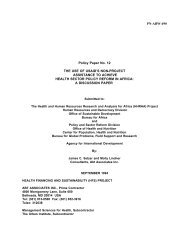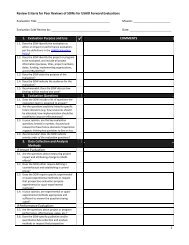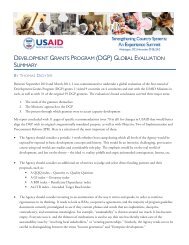Reforming Public Procurement in Emerging Market ... - KDID Portal
Reforming Public Procurement in Emerging Market ... - KDID Portal
Reforming Public Procurement in Emerging Market ... - KDID Portal
You also want an ePaper? Increase the reach of your titles
YUMPU automatically turns print PDFs into web optimized ePapers that Google loves.
<strong>Reform<strong>in</strong>g</strong> <strong>Public</strong> <strong>Procurement</strong> -- Syquia<br />
The illustration below (Figure 1) shows the “cause and effect” l<strong>in</strong>kage among the major criteria <strong>in</strong> a<br />
roughly sequential manner. Effectiveness is located at the top to stress that the ultimate objective of<br />
any procurement reform program is that agencies are able to acquire the best value for money. To<br />
atta<strong>in</strong> this, the process has to beg<strong>in</strong> with the development of an appropriate records management and<br />
data collection system, because a successful operation is one that proceeds <strong>in</strong> an <strong>in</strong>formed manner.<br />
Without <strong>in</strong>formation, no judgment can be made regard<strong>in</strong>g the <strong>in</strong>puts, outputs and outcomes of an<br />
agency’s system and operations.<br />
Accountability measures immediately follow data collection and monitor<strong>in</strong>g, because the quality of<br />
data gathered and <strong>in</strong>formation generated directly affects the quality and reliability of the evidence and<br />
other <strong>in</strong>dications of fraud or wrongdo<strong>in</strong>g, and it allows one to identify areas of vulnerability with<strong>in</strong> the<br />
system that require attention. It may be that these vulnerabilities exist by reason of an organizational<br />
structure that lends itself to non-transparent or collusive behavior, e.g., there are no <strong>in</strong>ternal audit units<br />
or decision-mak<strong>in</strong>g is highly centralized, so that the basic structure of an agency may have to be<br />
addressed even before consider<strong>in</strong>g implement<strong>in</strong>g a professionalization program with<strong>in</strong> the agency.<br />
Indeed, a professionalization program can only work if it operates <strong>in</strong> a properly structured<br />
environment, where each <strong>in</strong>dividual and office performs tasks that appropriately feed <strong>in</strong>to the work of<br />
another <strong>in</strong>dividual and/or office—all with<strong>in</strong> an atmosphere where each <strong>in</strong>dividual is held accountable<br />
for his/her responsibilities.<br />
The next step is to consider the state of the agency’s human capital, i.e. the procurement officers and<br />
staff. As mentioned above, these personnel are the enablers of any procurement reform program,<br />
because they are ultimately the ones responsible for implement<strong>in</strong>g the law <strong>in</strong> their respective agencies.<br />
As such, <strong>in</strong>ternal procurement processes can function properly only when these enablers amply<br />
perform their tasks <strong>in</strong> a proper work<strong>in</strong>g environment. In turn, when the procurement process<br />
<strong>in</strong>corporates the reform measures and reflects the pr<strong>in</strong>ciples of transparency, efficiency and economy,<br />
the agency should be able to procure goods and services effectively, i.e. with the desired quality and<br />
at the most reasonable cost. If, after the entire cycle, certa<strong>in</strong> gaps and weaknesses still exist, these<br />
should be identified through the agency’s data collection and monitor<strong>in</strong>g system so that the<br />
appropriate adjustments can be made, whether <strong>in</strong> the accountability measures, the organizational<br />
structure, the human capital element or <strong>in</strong> the manner <strong>in</strong> which the process is implemented.<br />
F<strong>in</strong>ally, strategy is located <strong>in</strong> the middle of the cycle, because it provides the approach for<br />
implementation of the reforms with<strong>in</strong> the agency, and it identifies the efforts that need to be<br />
prioritized dur<strong>in</strong>g the current cycle, as well as those that may have to wait until the next cycle.<br />
Fiscal Reform and Economic Governance Project 20







